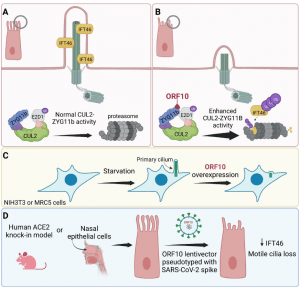The cilia that line the epithelial tissue of the airways are essential for the initial defence of the airways against pathogens (READ MORE). The cilia (hundreds on the surface of the epithelium) secret viscoelastic mucus which may trap foreign particles and/or pathogens.
This mucus, with trapped particles, is ejected from the body following guided movement of the cilia towards the pharynx. SARS-CoV-2 is a virus capable of evading the mucociliary clearance pathway. The virus appears to directly infect ciliated cells and destroy cilia. Open reading frame 10 (ORF10) protein from SARS-CoV-2 has been found to be responsible for the loss of cilia. The protein is involved in promoting degradation of cilia through ubiquitin-dependent degradation.
In a recent paper, Fonseca, et al., sought out to describe the interaction between ORF10 and ZYG11B and determine whether it promotes the spread of SARS-CoV-2 (Figure 1). ORF10 seems to interact with various enzymes such as E3 ubiquitin ligase adapter along with others which promotes the escape of the virus from the ubiquitin/proteasome pathway which aid in the degradation of antiviral proteins.

Figure 1: Figure 1. SARS-CoV-2 ORF10 impairs ciliogenesis by enhancing the activity of the E3 ligase CUL2ZYG11B. (A) The CUL2ZYB11B RING E3 ligase complex contributes to cellular protein degradation via ubiquitination. (B) Upon SARS-CoV-2 infection, the viral protein ORF10 binds the E3 adapter ZYG11B, increasing the ubiquitination activity of the complex, and inducing the proteasomal degradation of ciliary proteins, including IFT46. (C) ORF10 overexpression in serum-starved NIH3T3 and MRC-5 cells blocks primary cilium biogenesis and maintenance. (D) The lentiviral transfer of ORF10 is sufficient to induce cilia loss in human ACE2 knock-in mice and in primary human nasal epithelial cells, highlighting the role of this viral protein in SARS-CoV-2-mediated cilia disruption (Fonseca, et al., 2022).
In this present study the researchers found that SARS-CoV-2 targets the ubiquitin/proteasome pathway and subsequently leads to the loss of ciliary proteins, whereby SARS-CoV-2 ORF10 protein is responsible for this degradation which results in the reduction of viral particle clearance and promotion of viral dissemination.
Journal article: Fonseca, B. F., et al., 2022. A close shave: How SARS-CoV-2 induces the loss of cilia. Journal of Cell Biology.
Summary by Stefan Botha










